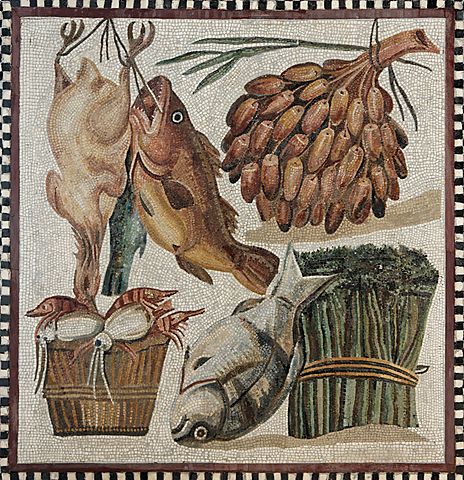
Ancient Romans ate various foods for sustenance. The majority of their food consisted of: vegetables, fruits, fish, meats, and nuts. They also flavored their food with pepper, cumin, and rue herbs. The poorest Romans ate different meals compared to the wealthy which is further discussed in this article.
Poor Roman citizens were forced to use local ingredients while the rich were able to obtain food from all around the empire. An example of wealthy eating in ancient Rome was importing: oriental spices, pine nuts, pumpkin, mutton, and dates from Egypt to enhance their cuisine. The poor romans on the other hand, ate a basic porridge that consisted of raw beans and various grains mixed with a fat of some kind. The rich would mix their porridges with olive oil as a fat. Sometimes they added small quantities of meat and cheese for protein. However, this was rare because meat was so expensive in ancient Rome.
Furthermore, eating frequencies differed among the classes. The poor had one or two meals while the wealthy had at least three. The major meal being the last was the focal point of eating and was considered the main meal in ancient Rome. As the Roman Empire become more power and extravagant, Roman citizen’s diet changed significantly. Early Roman food was not as complex as Imperial Rome. Today we know much about their food through literature and ancient Roman cook books that survived throughout history. However, it should be noted most roman recipes do not tell how much spices were used by ancient Roman cooks. Today it is very hard to recreate the exact dishes Romans ate during that time period. Yet, we have a general idea based on the information discovered.
Romans were notorious for their fish sauce that they used on everything. The sauce was called garum and was used in ancient Greek, Rome, and Byzantium times. It was sauce that was fermented fish intestines with lots of salt and used like ketchup today for enhancing food. Some say it is very similar to fish sauces found today in Asian counties and used in the same manner. It should be noted that this added flavor to the Roman cuisine and was widely loved by ancient Romans. Today we do not know much about Roman sauces and flavoring. Nevertheless, we know what ingredients they consisted of but not the exact measurements. Most of their sauces resembled a pesto and was very Mediterranean style flavoring.
Meat in Ancient Rome
Even though meat was not a common eating practice for the general citizen due to its cost, Romans did eat an array of meat dishes as a good source of protein. They included: wild boar which is a pig, venison which is deer, mutton which is lamb, kid which is baby goat, adult goat, baby suckling pigs, hare which is a jackrabbit and dormice which are small rodents native to the area. In respect to poultry dishes, Romans ate almost everything that was local to them and what was imported from around their empire. It consisted of: chickens, geese, ostriches, cranes, pheasants, pigeons, doves, thrushes, fig-peckers, and for the wealthy peacocks.
Most meats in ancient Rome were boiled and then roasted with a spicy sauce made from pepper or local herbs and spices. Cooking meat twice was standard practice due to a lack of refrigeration. As the empire became more decadent, other spices were brought to Rome from the Middle East and Egypt. Swine and pork were considered a great delicacy and were very expensive in ancient times. One more delicacy from that time area was stuffed dormice with minced pork and various spices like pepper, their famous fish sauces called garum (fermented fish and salt), and pine nuts. Romans rarely left behind ingredient amounts in their recipes. Therefore, it is assumed a variation of flavors could have been created depending on the chef’s taste.
The ancient Romans ate a good amount of seafood which consisted of shell fish and various fresh and salt water species native to Rome. They consisted of: carp, catfish, clams, crab meat, eel, flounder, hake, jelly fish, lobster, mackerel, mullet, mussels, octopus, oysters, perch, porpoise, prawns, rays, sardines, shark, sole, sward fish, trout, tuna, and turbot just to name a few. As with other meats, fish was also considered expensive and not found on the dinner table on a daily basis unless you were wealthy. One problem with seafood was transporting it to places were the sea was not close. The ancient Romans overcame this problem by preserving their fish by salting it or using a pickling methods. There is not much evidence Romans used a smoking methods as this was also a known way to preserve food for transportation or longevity. It was also believed that the Romans also raised fish in private pounds on a commercial scale to feed the inland citizens. Since Rome was surrounded by the Mediterranean Sea, much of the coastal communities incorporated fish into their diets.
Types of Bread in Ancient Rome
 Bread in Ancient Rome was very different from today. It was one of the most documented foods in ancient Rome. Bread was even found in Pompeii preserved due to the volcanic eruption that took a snapshot of ancient history. Roman bread appeared around 300 BC and became very popular in the later part of the empire when resources from all around the known world were flowing into Rome. As Rome acquired new territories, new techniques of producing fine bread found its way into the city of Rome. Around 168 BC when the first baker’s guild was created, this allowed pastry chefs to emerge throughout the Roman Empire. Most Roman bread varied in quality depending on the grain used to make it and who made it. Some were made with fine flours from wheat and others of bran alone. Most of the finer breads came in the later part of the empire as Rome expanded and conquered more territories. Before Rome became a metropolis, most beads were primitive and poor quality and very rough in texture. Ancient Romans ate more porridge instead of bread. Most bread baked in that time was known for its circular and flat shape.
Bread in Ancient Rome was very different from today. It was one of the most documented foods in ancient Rome. Bread was even found in Pompeii preserved due to the volcanic eruption that took a snapshot of ancient history. Roman bread appeared around 300 BC and became very popular in the later part of the empire when resources from all around the known world were flowing into Rome. As Rome acquired new territories, new techniques of producing fine bread found its way into the city of Rome. Around 168 BC when the first baker’s guild was created, this allowed pastry chefs to emerge throughout the Roman Empire. Most Roman bread varied in quality depending on the grain used to make it and who made it. Some were made with fine flours from wheat and others of bran alone. Most of the finer breads came in the later part of the empire as Rome expanded and conquered more territories. Before Rome became a metropolis, most beads were primitive and poor quality and very rough in texture. Ancient Romans ate more porridge instead of bread. Most bread baked in that time was known for its circular and flat shape.
Rome was known for giving rations of bread to its citizens as this was a fundamental right of being a Roman citizen. Slaves and non-citizens were not allowed to partake in bread rations. Bread was distributed for political reasons and not charity like one would think. Romans distributed as a form gaining control of citizens. Roman leaders thought a dissatisfied citizen was a dangerous citizen who could cause problems for the empire. It is important to remember that Roman leaders wanted to keep their citizens happy to stay in power. Even though they practices rationing of bread, it never worked as many of the leaders of Rome had sort periods of rule due to corruption. Bread also made non-citizens work harder to become a citizen as they could get rations.

